
Lip Fillers | Types of Dermal Fillers Used by Dermatologists in Edmonton
People may be overwhelmed with the huge selection of dermal fillers to choose from. Each variety has a specific substance which is used for different purposes and parts of the face and body. Each one has a unique formula with differing ingredients that help combat the signs of aging and give an aesthetically pleasing look. The most common ones available in Canada are hyaluronic acid, calcium hydroxylapatite, poly-L-lactic acid, polymethyl methacrylate, autologous fat transfer, and platelet-rich plasma.
Common dermal fillers used by dermatologists
Hyaluronic Acid
Hyaluronic acid (HA) fillers are the most common dermal fillers used by dermatologists. This natural substance is easily accepted and adapted by the body since it already exists there. As the body ages it loses HA. When this filler is injected it attracts water and binds to it, which in turn helps bring volume to the area treated. Because it can absorb 1000 times its weight in water the effect is noticeable. It not only attracts moisture it retains it.
HA fillers can be used in many areas to unwind the clock and give healthy, vibrant, moisturized skin on the face and body such as lips, cheeks, nasolabial folds and under the eyes. Some common product names of HA fillers are Juvederm, Restylane, Belotero, and Revanesse.
There are no adverse effects associated with adding more HA to the body since it is already naturally found there. When injected though there are risks involved because of the actual procedure. Even if a small risk, it is worth noting. Typically, most HA fillers last up to a year and some clients report a bit longer. After this time the body absorbs the ingredients and subsequent treatments are needed to sustain the results of younger and healthier looking skin.
Calcium Hydroxylapatite
Calcium Hydroxylapatite (CaHA) fillers are also approved for use in Canada and are commonly used in cosmetic fillers. This is a calcium-based substance that uses microspheres to treat deep lines and wrinkles. Dermatologists would describe it to be a gel-like material. Not only does it plump up the volume and smooth the surface of the skin, but it also triggers the growth of collagen. This natural substance in the body works much the same way as hyaluronic acid in that it plumps up the skin by attracting water and retaining it. Radiesse is the brand name for CaHA fillers.
Radiesse lasts for approximately fifteen months. Incredibly some clients boast of it lasting for 24 months. Even though CaHA fillers cost more than HA fillers they last much longer. But all good things do end. These fillers are not permanent and subsequent treatments need to be administered to maintain the results.
There are minimal possible risks with CaHA fillers such as redness, bruising, bleeding, lumps and swelling. Much of this is due to the poke from the needle and not the ingredients. However, if a patient is allergic to any of the ingredients in the solution, they could have a severe reaction. This is why a consultation with a reputable and experienced doctor is imperative before having any cosmetic treatment including this one.
Poly-L-lactic
Poly-L-lactic acid fillers are another viable option for sculpting your cheeks and temples. Some dermatologists even call it a liquid facelift without the downtime. They are approved for the Canadian market and the common brand name is Sculptra. It addresses larger areas that have volume loss. This filter also triggers collagen production just as Radiesse. This filler can last up to two years and because it treats larger areas of volume loss it does cost more than the entry level fillers that use HA.
This biodegradable filler comes from fruit acid. It is injected deep into the skin where it triggers collagen production. Like other dermal fillers mentioned the body eventually absorbs and metabolizes this substance so repeat treatments are necessary to sustain the desired results.
Sculptra has all the same side effects as other dermal fillers, which come from being injected with a needle. Redness, swelling and bruising may occur. It could also cause discoloration, discomfort, and itching. These are all common reactions.
Polymethyl Methacrylate
Polymethyl Methacrylate (PMMA) fillers are another option for deep wrinkles and volume loss. This filler is made up of a substance that is a 20/80 combination of PMMA microspheres suspended in collagen gel. These fillers are long lasting, and a common brand name is Bellafill. Like Radiesse this substance also triggers collagen production. Once the collagen from the filler dissolves your body’s natural collagen replaces the area under the skin, giving the increased volume you desire.
The same side effects as Sculptra exist for PMMA too. Things such as redness, swelling, lumps and itching are just some of the minor reactions. If you have allergies or sensitivities its important for you to get the approval of the expert injector dermatologist before choosing this type of filler.
Autologous fat transfer is the next type of dermal filler. This is a multistep process. First liposuction is used to take the fat from one part of the body then it is processed, after this it is injected into the areas needing volume. The results from this procedure are long lasting but may require multiple visits. Because this uses the patient’s tissue it carries no risk of allergies.
Platelet-rich plasma
Platelet-rich plasma (PRP) fillers are also unique to each person using this type of filler. The patient’s own blood plasma is extracted, processed, and injected into the skin. It triggers collagen production and evens out the texture and tone of the patient’s skin. It is even now being researched as a viable way to treat hair loss. The rich plasma stimulates growth and that brings a youthfulness to wherever it is used on the body.
Conclusion
No matter which type of filler you decide to use, you should always consult a reputable and experienced doctor or nurse like the ones at Edmonton Dermatology. They will take the time for a thorough consultation, discuss facts and help you research which ones are suitable for your needs based on the goals you have for antiaging treatment.

